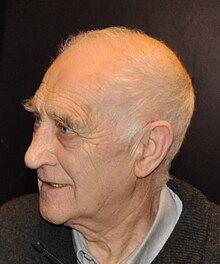Willem van der Poel
Willem van der Poel (born December 2, 1926 in The Hague ) is a Dutch computer pioneer. He is known for designing the ZEBRA computer .
Education
While still a schoolboy in Amsterdam in 1944/45, Van der Poel constructed his first computer with relay parts from telephone switching points, practically on his own. He studied physics at Delft University of Technology , graduating in 1950. While still at university, he made contacts with the Mathematical Center in Amsterdam and, as research assistant to Nicolaas Govert de Bruijn, developed a relay computer that was completed by other students in 1952 and used for lens calculations. It was programmable and very reliable, but slow (hence its name Testudo) and in operation until 1964. In 1950 Van der Poel attended courses with Maurice Wilkes in England, teaching on the Edsac computer.
At PTT: PTERA, ZERO and ZEBRA
From 1950 to 1967 he worked in the laboratory of the Dutch state telephone company PTT . There he built the tube computer PTERA, which was in operation from 1953 to 1958 and was the first electronic computer in the Netherlands. He had a magnetic drum store . Van der Poel regarded the successor ZERO as his most elegant computer design, which anticipated many features of the later ZEBRA (and had a micro-architecture which was later described as RISC ).
Van der Poel became head of the mathematics department of the laboratory of the PTT (called Dr. Neher Labor) and received his doctorate in mathematics (The Logical Principles of some simple computers ) at the University of Amsterdam under Adriaan van Wijngaarden in 1956 . The computer designed in the dissertation was built as a ZEBRA (Zeer Eenvoudige Binaire Reken Automaat, Very Simple Binary Calculator) by Standard Telephones and Cables in England and a total of 55 copies were delivered.
The operating system and software for his PTERA and ZEBRA computers were largely written by the deaf and blind mathematician Gerrit van der Mey, with whom Van der Poel worked from 1951 until van der Mey retired in 1979. He also designed the Algol and Lisp compilers for Zebra. For communication with Van der Mey, Van der Pol designed several Braille translators in the form of teleprinter / telephone and typewriter.
TU Delft
Van der Poel was a part-time professor at the TU Delft from 1962 and full-time from 1967. In 1988 he retired.
He was a visiting researcher at Stanford University from 1964/65 , at the Thomas J. Watson Research Center of IBM in 1975 and regularly at the University of Tokyo from 1977.
In 1970 he published a description of an ideal computer (SERA 69) for study purposes. As early as the 1960s his interest shifted increasingly to programming languages. 1962 to 1968 he was the first chairman of the IFIP Working Group 2.1 on Algol . He was involved in founding the IFIP Working Group 2.4 Systems Implementation Languages.
Honors and memberships
In 1971 he became a member of the Royal Netherlands Academy of Sciences. In 1960 he and H. Mol received the Visser-Neerlandia Prize for a number of braille translators. In 1984 he received the Computer Pioneer Award . In 1971 he received an honorary doctorate from the University of Bradford .
For four years he was chairman of the Dutch Society for Calculating Machines (Nederlands Reken Machine Genootschap, NRMG), founded in 1959, and represented it at IFIP from 1971 to 1977.
Private
He collects mechanical puzzles and plays the bassoon and flute next to the piano.
Others
The ZOI rule ( Zero, One, Infinity ) is ascribed to him in programming: you either don't need a thing of any kind, exactly one thing, or an unlimited number (which is why you should not specify an upper limit). The LIFO principle ( Last In - First Out ) is also used for subroutines. attributed. These paradigms served as the namesake for Zoi GmbH, which was founded in Stuttgart in 2017.
Web links
Individual evidence
- ↑ Described in Van der Poel: A Simple Electronic Digital Computer. Applied Sci. Research, (1952) 367-400
- ↑ The ZEBRA microcode is described in Van der Poel: Microprogramming and Trickology , in WE Hoffmann Digitale Informationswandler , Vieweg 1961, pp. 269-311
- ↑ Van der Poel (editor): SERA 69, defining rapport , Stichting Nederlands Study Center voor Informatica, 1970
- ↑ Willem van der Poel
- ↑ Stefan Mayr Winnenden: Big data instead of crumbs . In: sueddeutsche.de . July 25, 2017, ISSN 0174-4917 ( sueddeutsche.de [accessed November 11, 2017]).
| personal data | |
|---|---|
| SURNAME | Poel, Willem van der |
| BRIEF DESCRIPTION | Dutch computer scientist |
| DATE OF BIRTH | December 2, 1926 |
| PLACE OF BIRTH | The hague |
